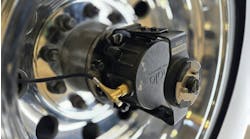How to leverage Big Data to improve vehicle maintenance processes
Thanks to advances in technology, telematics, onboard diagnostic systems, the Internet of Things (IoT) and more, vehicles are becoming increasingly more intelligent. Vehicles are also generating more and more Big Data. Basically, Big Data describes the large volume of data from traditional and digital sources, both inside and outside an organization.
Nowadays, fleets have huge amounts of vehicle and operations trip data available from their trucking management and maintenance systems, mobile communication systems, onboard sensors and telematics systems.
But it is not the amount of data that is important. Rather, it is what an organization does with the data.
Big Data – if collected and analyzed correctly – offers maintenance operations the potential to ascertain valuable insights for enhanced decision-making and improved operational efficiency. Among the “gems” hidden in Big Data are:
- Clues about the safety, efficiency, performance and vehicle health.
- Information for determining the root causes of failures, issues and defects in near-real time.
- How to streamline operations for more precise vehicle maintenance and repair scheduling and budget forecasting.
- Real-time vehicle utilization.
Reliability improvement
With high vehicle reliability, and thus availability, uptime is increasingly important as transportation solutions become more complex and the transportation industry seeks new ways of being competitive. Factors that impact vehicle reliability are vehicle quality, preventive maintenance actions and driver training, all of which help to reduce the risk of unexpected downtime for vehicle maintenance, repair and failures.
Having good data and effective data analytics – the process of examining large amounts of data to uncover hidden patterns, correlations and other insights – can allow a maintenance operation to move beyond preventive maintenance and into predictive maintenance. Predictive maintenance involves periodic or continuous component inspection and monitoring, looking for the presence of warning conditions that indicate that a component is about to fail so that as-needed, planned maintenance can be performed prior to an equipment failure.
This assists in keeping vehicles in peak performance shape, increasing efficiency and lowering costs.
But there are a number of significant challenges to achieving such intelligence. Among them:
- Understanding the sources of the data.
- Having good and complete data.
- Being able to quickly find the relevant data.
- Making sure the data is accurate and timely.
- Understanding who will be using the data and how they will interpret the information.
- Putting the data in the proper context.
CMMS
A great tool for helping to manage and mine Big Data is CMMS (computerized maintenance management systems). These systems are designed to give users immediate insight into the state of a maintenance organization’s operations and needs with comprehensive work order schedules, accurate inventory forecasts and instant access to hundreds of invaluable reports.
A good CMMS makes maintenance management easier by empowering maintenance managers with complete and accurate information and data so that they can make more educated decisions.
Four ways
There are four top ways CMMS can help with managing Big Data, say officials with Eagle Technology (www.eaglecmms.com), a leader in the development and sale of CMMS and Enterprise Asset Management (EAM) solutions.
1. Stop panic fixes
Computer maintenance management systems can help analyze work orders and maintenance logs to monitor vehicle performance from day to day and week to week, say the officials. This helps spot potential issues before they become problems and avoids having to react to a vehicle breakdown.
Once maintenance managers have that capability, they can control when and how they maintain their vehicles, making maintenance proactive instead of reactive, they note. When maintenance and repairs are performed in time and at when scheduled, vehicles operate better and longer.
2. Improve resource management
A CMMS gathers, analyzes and synthesizes data from a wide variety of diverse sources, including vehicle maintenance software, other maintenance programs, order processing software, etc., Eagle Technology officials says. This provides maintenance managers with a bigger picture.
With such information, better decisions can be made on how to best allocate resources to the right processes, they add. Moreover, the information can be used to identify areas that require changes. For example, changing vehicle routing to improve efficiency or replacing an asset that’s been racking up small fixes that add up to big expenditures over time.
3. Ensure consistency
In today’s transportation environment, it is important to have processes that result in consistent vehicle reliability and uptime. For this to happen, say Eagle Technology officials, every employee involved with the maintenance operation must make sure things get done the right way every time.
A good CMMS can help build checklists that workers can refer to as they work, helping to ensure that they are following the right process every time, they explain.
In addition, these checklists provide a way to retain the intelligence that used to be lost when a long-time employee retires, leaves or is unable to perform his/her duties. New or replacement workers can used the checklists and understand the reasons behind the various procedures.
4. Build accountability
No organization wants to believe its workers would deliberately cut corners or do slipshod work, but it can happen, point out Eagle Technology officials. CMMS can track all the tasks assigned to employees and their performance in each task.
By helping pinpoint who does what and when, CMMS can be used to reward excellent employees and get potential problem workers the help they need to become valued members of the organization.
Furthermore, CMMS can automate work requests so the burden no longer falls on faulty human memory, they add. Once the requests are made, they become part of the system’s cache of data. Maintenance histories print out at the click of a button, documenting all the steps taken, protecting maintenance managers and workers.
GIGO
To get the most value from a CMMS, it has to have good data. Think GIGO: garbage in, garbage out. The quality of the output is determined by the quality of the input.
Eagle Technology officials offer this advice on what data should be in a computerized maintenance management system.
- Complete list of current assets
For CMMS to function properly, they need to contain a complete list of assets, along with manuals, purchase dates, costs and maintenance cycles. As the IoT continues to expand, having all assets connected through a central database will help maintenance managers plan ahead and create appropriate workload assignments.
- Schedule for preventative maintenance
For many maintenance organizations, tracking the various preventive maintenance (PM) scheduling for different assets can be difficult, note the officials. Making sure that vehicles are offline at appropriate times avoids disrupting the workflow and unanticipated consequences.
A good CMMS can track what vehicles need maintenance at what times, plus help to schedule maintenance at times that will have the least impact on workflow. This can also assist maintenance managers track what PM has occurred and make sure that all necessary supplies for maintenance are stocked.
- Unplanned work events
Unless both a legacy system and maintenance staff are scrupulously careful, tracking unplanned work can be haphazard at best, Eagle Technology officials observe. Because CMMS alerts maintenance personnel to problems with vehicles as they arise, and tracks when problems are resolved, maintenance managers can accurately track how often vehicles are breaking down and how much money is being spent on unplanned maintenance.
This can help organizations make data driven decisions on when to purchase new equipment or replace worn out ones. This is one of the primary ways that CMMS can drive return on investment, the officials note.
- Who completed the work
Too many legacy systems track the work that was completed but fail to accurately record who completed the work. This can leave companies vulnerable to training issues or communication failures which can be difficult to manage.
If a maintenance manager realizes that one particular staff member needs retraining on a particular piece of equipment, making arrangements for this is simple, say Eagle Technology officials. If the manager first needs to figure out who is making the mistake, then the issue becomes much more complex.
Moreover, having accurate work records can help identify any patterns of internal loss or theft.
- How the problem was solved last time
Maintenance staff often needs to manage assets which have been in service for long periods, Eagle Technology officials say. When problems have occurred in the past, maintenance staff can take the time to track down the person who solved the problem last time and hope that they have an accurate memory, or CMMS can begin to develop an institutional memory.
When technicians make notes about how they solved a problem, that knowledge becomes something that future technicians can access. If the problem requires multiple attempts to solve, it will be easier for the maintenance staff to understand what has already been done.
- Predictive maintenance
While preventive maintenance can help keep problems at bay, the Eagle Technology officials say that a great strength of the newest wave of CMMS is the ability to identify when a piece of equipment is likely to break down before it happens.
By tracking slowly building errors or problems, CMMS can alert a technician to a potential problem. A technician can then conduct a repair at a time which is convenient for the organization, instead of interrupting the workflow with an unscheduled problem.
Takeaway
Dealing with Big Data can be overwhelming, but when done right, it presents unprecedented opportunities for insight for making more informed business decisions to help drive any maintenance organization toward greater efficiency, better use of resources, reduced vehicle downtime and improved asset life.
A fully-featured computerized maintenance management system can be very helpful in making this happen by effectively utilizing existing data sources and displaying outputs in a simple and relevant fashion. This enables maintenance managers to increase their understanding of their vehicles and maintenance organization.




